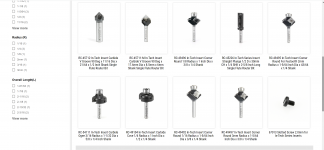Hi,
the Festool Radius Router Bits for edge banding seem convenient because they trim and round-over edge banding in one pass. Has anyone used them in a router table? Seems to be a nice way to get a kind of stationary solution to trimming edge banding. Or am I missing something?
1mm Radius:https://www.festoolproducts.com/festool-499811-radius-router-bit-for-edge-banding-1mm-radius.html
2mm Radius:https://www.festoolproducts.com/festool-499809-radius-router-bit-2mm.html
(there also is 1.5mm and 3mm)
the Festool Radius Router Bits for edge banding seem convenient because they trim and round-over edge banding in one pass. Has anyone used them in a router table? Seems to be a nice way to get a kind of stationary solution to trimming edge banding. Or am I missing something?
1mm Radius:https://www.festoolproducts.com/festool-499811-radius-router-bit-for-edge-banding-1mm-radius.html
2mm Radius:https://www.festoolproducts.com/festool-499809-radius-router-bit-2mm.html
(there also is 1.5mm and 3mm)

